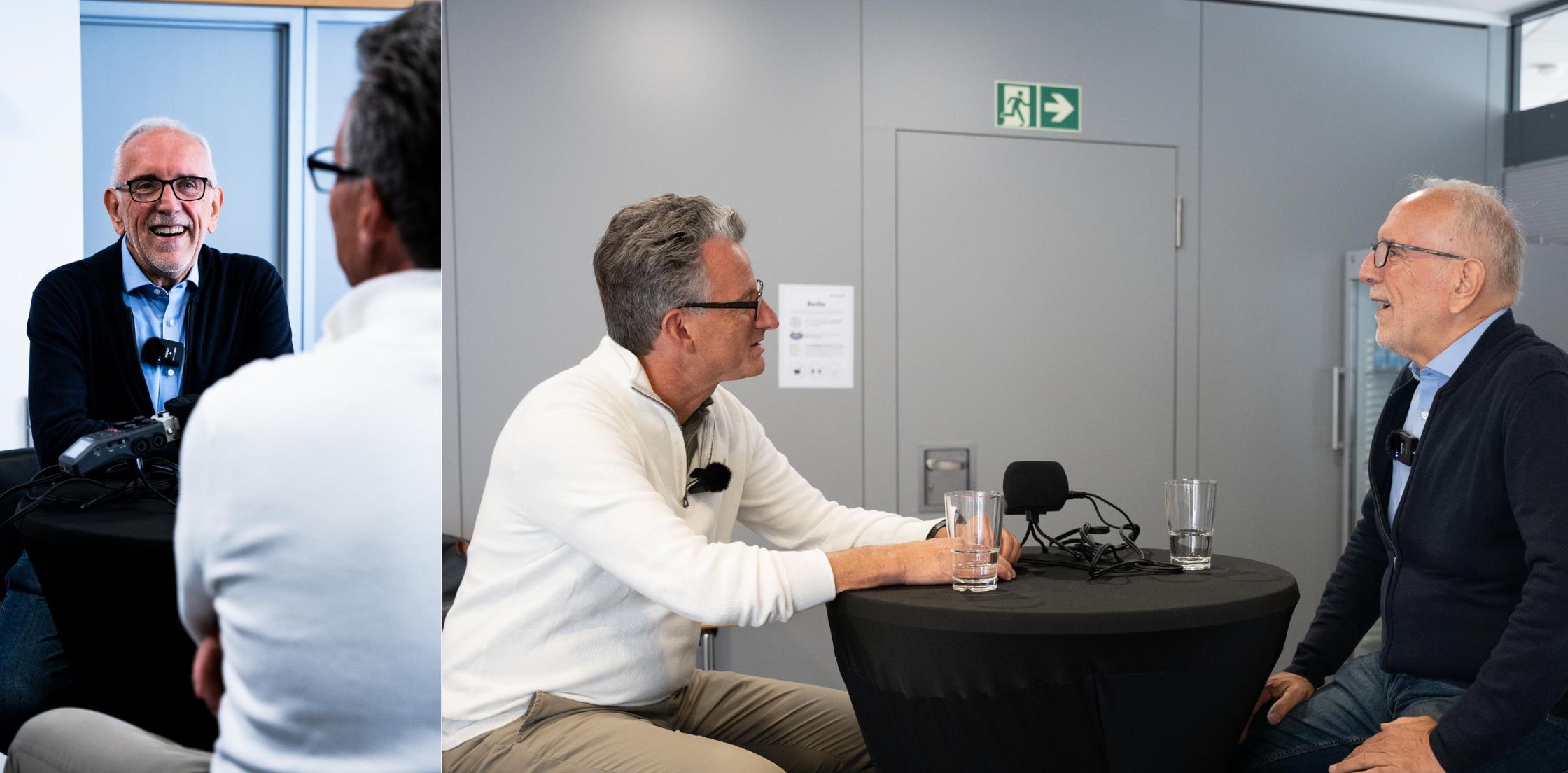persolog founder Friedbert Gay in an interview with Klaus Zimmermann
Why does persolog exist? How does the persolog® Personality Factor Profile work? Today you can immerse yourself in the history of persolog. Because our founder and CEO Friedbert Gay was an interview guest in the podcast of Klaus Zimmermann from Zimmermann GmbH & Co. KG and gave an exclusive insight into his work and the persolog® Personality Factor Profile. Here you can find an excerpt of the interview.
K. Zimmermann: The persolog® Personality Factor Model is a gigantic tool that we have been using in our company for many years to recruit employees. Tell us how your personal work came about.
Friedbert: I was born in 1956 and grew up in Wilferdingen near Karlsruhe. I would say I am a late developer. When I first worked as a master electrician in sales, I realized after a few weeks that people often don’t have problems with technology, but that they can’t get along with other people. It all started with this realization.
From 1990 onwards, I introduced the Personality Factor Profile from the US, first in Germany and then in Austria and Switzerland. This is my lifetime achievement, which began 33 years ago. I have enjoyed a life in which I have traveled a lot. That has shaped me a lot. My eldest daughter, Debora Karsch, now runs the company operationally. I am now allowed to do the things that interest me. That is a privilege.
persolog GmbH has 40 employees, which is quite a lot in the field of ” advanced education” . persolog develops advanced education concepts that can be used internationally. We can deliver in 34 languages and therefore travel all over the world. We have partners and distributors in 16 countries. The headquarters are located here in Remchingen-Wilferdingen.
K. Zimmermann: You said you can deliver 34 languages. Was that the case from the start or how did it develop?
Friedbert: In the beginning, we were a “garage company” in Jörg Knoblauch’s house – that’s where it all started. It took a few years to build up a company like that. We invested around DM 1.4 million in it until it was up and running. I could never have done that on my own. It took a lot to achieve anything. At some point, we started translating content from the American language and realized that we also needed a lot more in the German context. In the years 1997-1999 there was a lot of growth. I also wrote the book “The Behavioral Blueprint” with Lothar Seiwert, for example, which was also successful. We worked on a wide variety of products.
We received various feedback from customers about what they needed profiles for, e.g. in the areas of sales, leadership or conflicts. It was also often about time management. The persolog® Personality Factor Profile was not just a questionnaire, but a tool for reflection. You were given something, could go home with it and it really told you something about yourself. That’s also the big difference between questionnaires and learning tools. It’s always about presenting a specific problem in a simplified way and getting to the heart of the matter from this situation. I am a person who recognizes potential and then does something with it and moves forward. That’s how I would describe myself.
K. Zimmermann: With regard to the persolog® Personality Factor Profile: you answer 2×24 questions and get an accurate result. Can you explain the background to how this result came about in the first place?
Friedbert: The profile was developed at the University of Minnesota. The basic development took place in the 1970s. Professor Dr. John G. Geier, responsible for psychology at the medical faculty, worked at this university. One day, the dean came to him and said that the prospective doctors had to talk to the people, not with the people, and give them feedback. But the people resisted: they didn’t want to be scanned by a clinical instrument. Professor Dr. John G. Geier then received 1.5 million US dollars to develop an instrument that was not clinical. At that time, experience showed that just a few questions were enough to get a meaningful result about people’s behavior. Professor Geier wanted to make it possible for people to think about and reflect on themselves. So he developed this questionnaire.
After two years of developing this learning instrument, there was a comparative study with famous studies in 1972, as the questionnaire also had to be publicly tested. From 1988 to 2000, he began researching again. From 2000, we revised the profile and checked it quantitatively. Since 2004, we have had Prof. Geier’s profile as we have it today – with two questionnaires. Questionnaire 1 deals with the question “How are you most likely to behave?” and in questionnaire 2 you answer the question “How are you least likely to behave?”
K. Zimmermann: Why does the profile change when the focus changes?
Friedbert: Kurt Lewin said: “Behavior is a function of person and environment.” The person is relatively stable, but the environment can be different. That’s why behavior can also be very different. The psychologist Carl Rogers said: “People have several self-images that they manage in a completely authentic way.” Let’s take an example: a manager almost always has employees they can count on and employees they are worried about what they will do today. And if you compare the manager’s conversations with the two categories of employees, you will notice big differences. While one has a lot of freedom, the other is managed more closely and controlled more often. Communication with employee A is therefore very different from that with employee B.
Or let’s think of a customer with whom the conversation is going great and a customer who is very difficult for you: these are simply different behaviors that we have to show here and it is completely normal that it depends on the environment. I only know a handful of people for whom the environment doesn’t play a role. I’ve already had conversations with employees who said: “You know, I don’t have to show this behavior at home because my partner does.” It’s completely normal for us to behave differently at home than we do at work.
K. Zimmermann: Why does the persolog® Personality Factor Profile work so well?
Friedbert: It’s simply that it speaks into life situations and the participant can immediately do something with it. You can often observe that. With the personality profile, we are talking about the first approach and the first reaction of people, which is often different. Recognizing this is very helpful. It allows you to recognize how a person behaves and you can do much better justice to them.
For example, I know that I present all the information to someone who is very cautious in a very factual way. I can give someone who is highly dominant a clear and direct choice: Do you want A, B or C? They want to decide for themselves. Someone with a high level of steady behavioral has an easier time with a recommendation. I pick up someone who is very influencing by expressing my enthusiasm for something. In this way, I can do justice to my customers, my employees, my partner or even my colleagues.
It’s always about deciding: What can I do so that the best that is inherent in my counterpart can unfold. That’s why the persolog® Personality Factor Profile is so powerful.
You can listen to the full interview here: www.zimmermann-strategie.de



